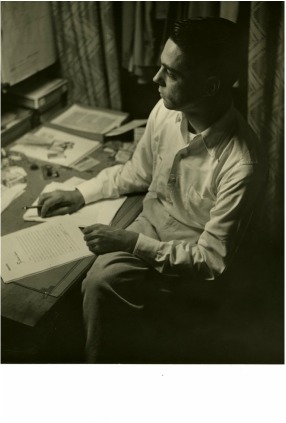Foote's Early Writing Career
Shelby Foote, most famous for his three-volume history of the Civil War, began his career as a fiction writer, and his earliest novels – Tournament (1949), Follow Me Down (1950), and Love in a Dry Season (1952) – formed him as a writer. As a young copyeditor working at Greenville’s Delta Star newspaper, Foote branched out from writing and editing articles to create fiction.[1] Inspired by the works of Faulkner and Proust, Foote drafted very early versions of his first novel, Tournament, in the late 1930s. Focused on the life of Hugh Bart, a character modeled after Foote’s own grandfather who gambled away the family wealth, the first completed manuscript of Tournament was rejected around 1939. When Foote returned to the manuscript after the war, he removed most of the writing style of his idols except for Proust, which he expanded upon, and Tournament was finally published in 1949.[2]
Foote’s second published novel, Follow Me Down, quickly followed Tournament in 1950. The inspiration came from a 1941 murder trial that Foote witnessed in his hometown of Greenville, Mississippi.[3] Reviews of Follow Me Down, however, were mixed. Literary critic Seymour Krim noted, “Very few young writers are able to write as sharply or as shrewdly as Shelby Foote. ‘Follow Me Down’ is this young ex-marine’s second novel, yet it is written as confidently as if it were his twenty-second.”[4] On the other hand, others argued that Foote’s style was too repetitive. Foote’s harshest critic, arguably, was his literary hero and friend Faulkner, who told Foote to “do better next time.”[5]
After the publication of Follow Me Down, Foote found himself in a sort of “dry spell,” unable to find the right words, and only producing a couple of pages a day.[6] That was until Foote’s breakthrough, described in a letter to Walker Percy: “I approached work sluggishly Monday morning and all of a sudden something took me by the hair. I had to hold back to keep from covering reams of paper with gouts of words. By yesterday afternoon (Thursday) I had produced 5000 of the best words I ever wrote.”[7] Foote’s writing drought was over, and the writing was his best yet. His third novel, originally titled “The Arms You Bear” from an A.E. Housman poem and later renamed Love in a Dry Season, came out in late 1951.[8]
Foote found success in those three consecutive years, but his writing proved difficult in the following two. After a 1952 divorce and a 1953 move to Memphis, Foote slowly began to piece together his new novel, which offered a fresh perspective. Published in 1954, Jordan County: A Landscape in Narrative, focused on the landscape of a fictional Mississippi county. Its major theme, according to Foote’s biographer Stuart Chapman, was “art as liberator.”[9] While Foote called it a novel, Walker Percy’s biographer Jay Tolson claimed the book to be “more a cycle of stories linked by common geography.”[10] In the years that followed, Foote began his twenty-year venture of writing the Civil War trilogy. Thanks to his early novels, Foote’s works of history reflected the same eloquent, detailed, and anecdotal style.
